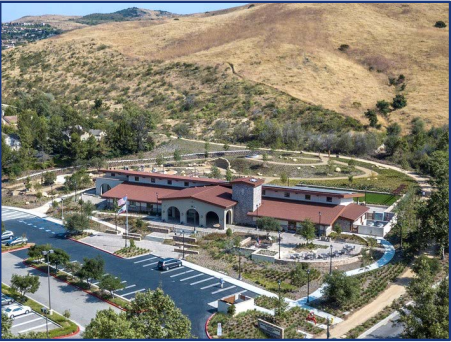 By Mike Allen
By Mike Allen
Photo: llustration of the long-planned Santee Community Center, via HMC Architects
May 14, 2021 (Santee) -- The ongoing pandemic has forced everyone, including local elected officials, to reevaluate their previous plans.
That’s what happened May 12 when the Santee City Council pressed the pause button on two long-planned decisions, building a community center and joining a Community Choice Aggregation program.
The latter refers to a strategy of purchasing electric power from renewable energy providers outside of San Diego Gas & Electric as a way to get to zero greenhouse gas emissions faster.
While the Council made it clear that the city wasn’t abandoning either plan, some members stated the pandemic and the changes it has wrought means the city must step back and take a closer look at past decisions.
Councilwoman Laura Koval said cities are taking a harder look at how they deliver services to residents, and that bringing these services to neighborhoods instead of constructing a new center might be more effective and certainly would save money.
“I would hate to build a beautiful community center, and it is beautiful, no doubt about it, but then have all this vacant space around the city (going unused). Things are going to change,” Koval said.
Mayor John Minto noted that instead of constructing a new building, the city could take over some of the recently vacated spaces such as the Office Depot at Trolley Square mall, or other commercial spaces where tenants are struggling.
Councilman Rob McNelis said the cost of materials related to constructing new buildings has risen by 400 percent, and likely wasn’t going to return to some normalcy for a few years. He also noted a rise in vacant commercial space in the city, caused by a big increase in people ordering their goods online, rather than shopping at a store.
“There’s a lot of space opening up, and it’s because big box stores are not making it,” he said.
In early 2019, the Santee Council voted 4-1, with Mayor John Minto opposed, to approve building a community center at a site adjacent to the Cameron YMCA on a 40,000 square foot parcel now used as a parking lot. Minto wanted the center to include space for a library, which is not part of the current configuration.
At that time, the cost for the first phase, a two-story building was estimated to cost between $8 million and $13.5 million. The newest estimate is $12.8 million. However, two additional phases will increase the cost to above $50 million.
Finance director Tim McDermott said the city’s budget for the project is at $9 million, and would generate the funds for the first phase over the next two fiscal years.
Councilman Ronn Hall pointed out another vacant space in the Home Depot shopping center, HomeTown Buffet, was also available. Hall didn’t want to drop the project all together. “I’d hate to give up on the project completely,” he said.
In the end, the council directed its staff to return in about four months with a report on options for the community center, including its financing, location, size, and eventual build-out. During that time, the Council said it would hold a public workshop on the issue.
The selected firm to create the center’s engineering and design plan was HMC Architects, a California firm with offices in San Diego, Los Angeles and Ontario, which beat out 19 other firms vying for the work. The firm was described as among the top design firms in the nation, and did the design of the replacement of the Las Colinas Women’s Detention Facility in Santee.
In another move, the Santee council decided it needs to further study all the ramifications of entering into a CCA given what has happened to several existing CCAs in other parts of California.
The Council approved an ordinance in October 2019 to implement a CCA program, but didn’t determine whether that would be done on its own or through an arrangement with other cities.
Koval asked her colleagues to see how other CCAs are combining as a way to survive and continue offering customers reduced energy rates. She noted San Diego County is apparently joining a joint powers authority (JPA) headed by the city of San Diego, and that may not be the best format for a small city like Santee. Last month, the Board of Supervisors voted to hold discussions with the two existing CCAs for a potential partnership.
Koval and other councilmembers said the San Diego JPA will use a “weighted vote,” giving larger cities more votes based on population and should be avoided at all costs.
Hall said the supposed savings on electric bills coming with a CCA doesn’t seem to be true. “I’m in no rush to get ourselves to be in a position where we’re paying 3 percent more, rather than saving 1 percent (the estimated benefit from joining a CCA) at a cost of $300,000 on top of that.”
The $300,000 referred to by Hall was the estimated membership fee cities would have to pay for start-up costs to hire staff and purchase power from renewable power companies.
Also complicating things is the fact that SDG&E set goals of reaching total power generation from renewable sources by 2045, and today obtains about 44 percent of its power from solar and wind, according to a city staff report.
Several councilmembers noted that SDG&E is planning to abandon the power generation function altogether and concentrate solely on transmission and billing operations. Under a CCA, the only thing the program does is purchase power from renewable sources. Transmission and managing customer bills would stay with SDG&E.
There’s all too many unknowns at this stage, and delaying a decision on joining any entity is the best way to go, said Hall.
“At this point I think we should sit tight and wait till this whole thing shakes out, and then we can probably see what’s going on,” Hall said. “I see bad things here for the next two or three years.”
The city settled a lawsuit filed by Preserve Wild Santee and other environmental groups last year over its climate action plan. That agreement calls for the city to make a good faith effort to either create its own or join a CCA.
Given that info, Hall said, “So let’s attempt our best for the next two or three years.”
Minto concluded the issue by saying the consensus of the Council was to direct the city’s staff to continue to investigate the CCA landscape to comply with the settlement agreement, and be on the lookout for something unexpected.
“You never know what’s going to pop up. It might be some great miracle that comes along,” he said.
 Mike Allen writes about government agencies and other topics for East County Magazine, mainly covering the Santee City Council. Among the newspapers he’s written for are the San Diego Business Journal, San Diego Daily Transcript, the Vista Press, and the Seattle Post-Intelligencer. He has won numerous journalism awards including a fellowship to the Stonier School of Banking by the American Bankers Association while employed as a financial reporter. He is a graduate of Fordham University in Bronx, N.Y. where he earned a bachelor’s degree in communications. He now lives in Santee.
Mike Allen writes about government agencies and other topics for East County Magazine, mainly covering the Santee City Council. Among the newspapers he’s written for are the San Diego Business Journal, San Diego Daily Transcript, the Vista Press, and the Seattle Post-Intelligencer. He has won numerous journalism awards including a fellowship to the Stonier School of Banking by the American Bankers Association while employed as a financial reporter. He is a graduate of Fordham University in Bronx, N.Y. where he earned a bachelor’s degree in communications. He now lives in Santee.
East County Magazine gratefully acknowledges the Facebook Journalism Project for its COVID-19 Relief Fund grant to support our local news reporting including impacts on vulnerable communities during the COVID-19 pandemic. Learn more: #FacebookJournalismProject and https://www.facebook.com/fbjournalismproject/.
You can donate to support our local journalism efforts during the pandemic at https://www.EastCountyMedia.org/donate.
 By Mike Allen
By Mike Allen Mike Allen writes about government agencies and other topics for East County Magazine, mainly covering the Santee City Council. Among the newspapers he’s written for are the San Diego Business Journal, San Diego Daily Transcript, the Vista Press, and the Seattle Post-Intelligencer. He has won numerous journalism awards including a fellowship to the Stonier School of Banking by the American Bankers Association while employed as a financial reporter. He is a graduate of Fordham University in Bronx, N.Y. where he earned a bachelor’s degree in communications. He now lives in Santee.
Mike Allen writes about government agencies and other topics for East County Magazine, mainly covering the Santee City Council. Among the newspapers he’s written for are the San Diego Business Journal, San Diego Daily Transcript, the Vista Press, and the Seattle Post-Intelligencer. He has won numerous journalism awards including a fellowship to the Stonier School of Banking by the American Bankers Association while employed as a financial reporter. He is a graduate of Fordham University in Bronx, N.Y. where he earned a bachelor’s degree in communications. He now lives in Santee.











Comments
Santee Community Choice Aggregation
We'll reach 0 carbon emissions 10 years faster, save everyone $1, and have electricity from about 9 o'clock in the morning, until 4 o'clock in the afternoon.